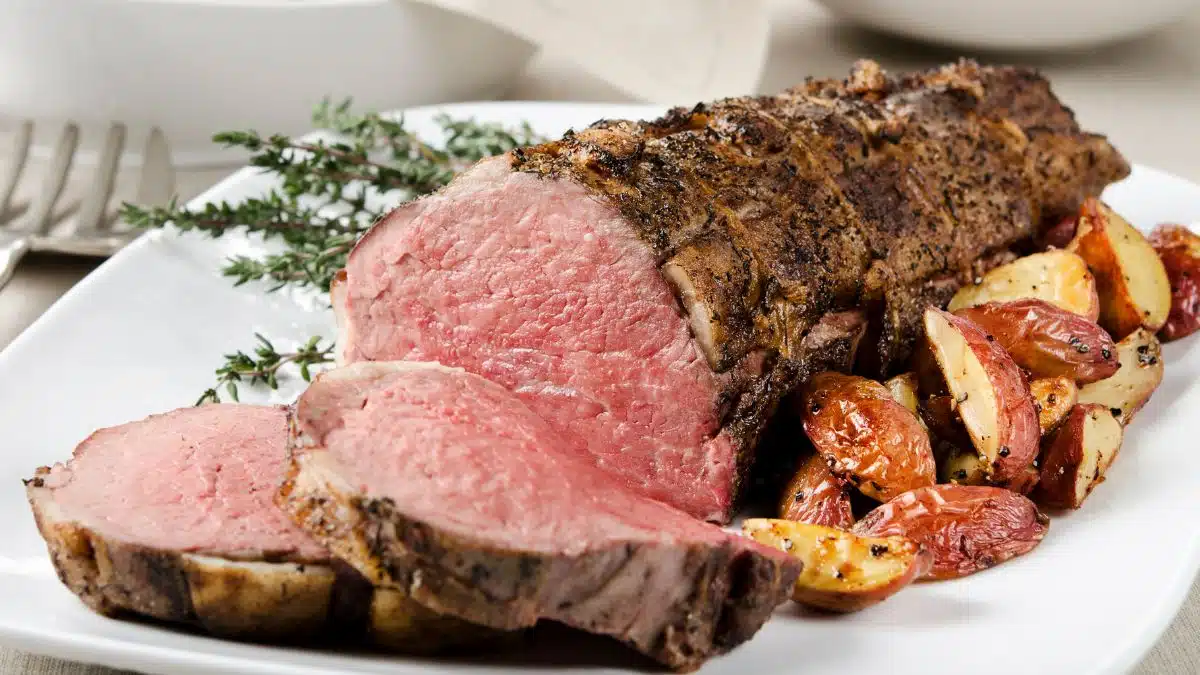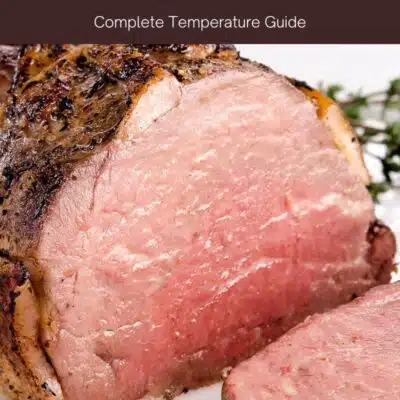Understanding beef tenderloin internal temperatures can be incredibly useful in knowing when your meat is perfectly cooked. You'll have tenderloins that are juicy, flavorful, and prepared exactly how you like them. Once you learn how to check the temperature, you'll never have to guess when it's done cooking again.

Jump to:
Internal Temperatures For Beef Tenderloin
If you are about to get started on preparing a delicious beef tenderloin meal, you need to know the ideal internal temperature for it to be perfectly cooked. Go ahead and get rid of any guesswork, and use a meat thermometer so you know exactly when it's done cooking!
Overcooking your beef tenderloin will make it tough, dry, and flavorless, so you definitely want to avoid it. With this simple guide, you won't have to worry about making any mistakes.
Ideal Beef Tenderloin Internal Temperature
Beef tenderloin is best when enjoyed medium-rare, which has an internal temperature of 130-135°F (54-57°C). It is a relatively lean cut of meat that could easily become dry and begin to lose its flavor if you cook it past medium.
However, for safety reasons, the USDA does recommend that all raw beef be cooked to an internal temperature of 145°F (62°C), which is considered to be a medium level of doneness.
In order to keep your tenderloin tender, juicy, and flavorful, I don't recommend cooking it beyond this point. However, many people do prefer their beef to be more on the medium-well or well-done side.
For medium-well, your pork tenderloin will have an internal temperature of 150-155°F (65-68°C), while a temperature of 160°F+ (71°C+) will indicate that it is well done.
For more general beef temperature information, take a look at my guide on beef internal temperatures.
Best Meat Thermometer
To get started, you'll need a meat thermometer in order to check the internal temperature of your tenderloin. There are a few different types of meat thermometers on the market, but a digital instant-read thermometer is a great option.
Not only does this variety of meat thermometers work incredibly well, but it can be very budget-friendly. You can find them at any grocery store or supermarket as well as online.
I highly recommend picking one up if you don't have one already!
How To Check The Internal Temperature
Checking the internal temperature of your beef tenderloin is a very easy and simple task. Just insert the thermometer probe into the thickest portion of the meat for the most accurate reading.
Wait for the temperature to stabilize (the amount of time this takes could vary based on the model of your thermometer, but it should only take a few seconds), and then read the screen.
If you find that your beef tenderloin is not cooked to your desired level of doneness, let it continue cooking for a few more minutes. If it is as well done as you would like it to be, go ahead and remove it from the heat source so and let it rest.
>>>See All Of My Tasty Recipes Here!<<<
Resting Beef Tenderloin (& Carryover Cooking)
It's important that you give your beef tenderloin some time to rest after removing it from the heat. Place it onto a platter or cutting board and loosely tent it with some aluminum foil.
Letting the tenderloin rest gives the juices some time to redistribute back into the fibers of the meat, resulting in a tenderloin that is juicy and flavorful. Go ahead and let the meat rest for about 10 minutes before you slice it and serve.
During this resting time, the beef will continue to cook (called "carryover cooking"), and the internal temperature will actually rise another 5°F. This is why there is a 5°F range for each level of doneness.
For example, if you want your beef tenderloin to be medium-rare, you'll want to remove it from the oven (or other heat sources) when the temperature reads 130°F (54°C). After resting, the meat will have an internal temperature of 135°F (57°C) and be perfectly cooked.

Beef Tenderloin Temperatures Reference Chart
| Level Of Doneness | Internal Temperature | Appearance |
|---|---|---|
| Rare | 120-125°F (48-51°C) | Bright red center with light red exterior |
| Medium-Rare | 130-135°F (54-57°C) | Pink center with gray/brown exterior |
| Medium | 140-145°F (60-62°C) | Pink center with brown exterior |
| Medium-Well | 150-155°F (65-68°C) | Brown center and brown exterior |
| Well Done | 160°F+ (71°C+) | Brown center and dark brown exterior |
Now that you understand beef tenderloin internal temperatures, you are ready to get cooking! Leave a comment down below and let me know how you prefer to have your beef cooked!
🥩Best Beef Recipes
- Grilled Chuck Roast - A mouthwatering roast with so much marbling and flavor that you'll only need 2 ingredients.
- Carne Picada - Flavorful minced meat that can be used in burritos, chilis, enchiladas, and more.
- Slow Cooker Brisket - Brisket is coated in a dry rub and then placed in the crockpot for a set-it-and-forget-it meal.
- Beef Top Round Roast - Tender and juicy meat with a perfectly caramelized crust.
- Instant Pot Rump Roast - A ridiculously easy and delicious dinner that only uses 4 ingredients.
- Steak Fajitas - Classic steak fajitas are the perfect meal for any day of the week.
Do you love a recipe you tried? Please leave a 5-star 🌟rating in the recipe card below and/or a review in the comments section further down the page.
Stay in touch with me through social media @ Pinterest, Facebook, Instagram, or Twitter! Subscribe to the newsletter today (no spam, I promise)! Don't forget to tag me when you try one of my recipes!
📖 Recipe Card
Beef Tenderloin Internal Temperatures: Chateaubriand (+Tips & Tricks!)
Ingredients
- 2 lb chateaubriand
- 1 tablespoon olive oil (extra virgin)
- 1 tablespoon Kosher salt
- 1 teaspoon ground black pepper
(Note: 2x or 3x only changes the ingredient list)
Instructions
- Get started by preheating your oven to 400°F (205°C).
- Meanwhile, place a cast iron skillet over medium-high heat and drizzle in the olive oil.
- Generously season the beef with salt and pepper, making sure to cover all sides of the meat.
- Once the oil in the skillet begins to shimmer, place the seasoned chateaubriand into the pan. Sear each side until lightly browned (about 2-3 minutes per side). Don't forget to sear the ends as well (using tongs if needed).
- Once seared, transfer the entire cast iron pan to the middle rack of your preheated oven and immediately reduce the temperature to 350°F (175°C).
- Cook for 15-20 minutes or until the internal temperature of the meat reaches 125°F (52°C) for medium-rare.
- Remove the cooked meat from your oven and move it to a cutting board or serving tray. Then, tent a piece of aluminum foil over the top of the beef and allow it to rest for 5 minutes before slicing and serving.
Notes
- For extra flavor, you can dry brine your chateaubriand before cooking. To do so, season all sides of the meat generously with salt and pepper before placing it into the refrigerator uncovered. You can allow it to brine for a minimum of 1 hour or up to 3 days.
- If you want to serve your beef alongside a red wine reduction, simply place the cast iron skillet back onto the heat after removing the meat (and take a look at my recipe here!)
- I recommend enjoying your chateaubriand when it is cooked to a medium-rare level of doneness. For more beef temperatures, take a look at my guide here.
- Plan ahead and try to only prepare as much chateaubriand as you need. For this premium portion of beef, I don't recommend storing and reheating because it has the best flavor and texture when enjoyed directly after cooking.



Comments
No Comments